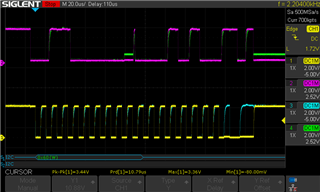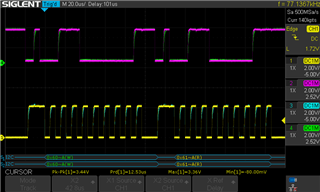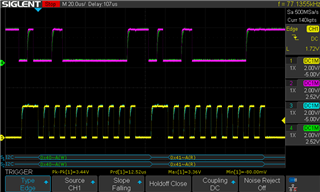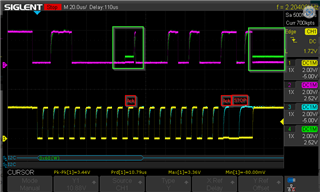Other Parts Discussed in Thread: BQ76942, BQ76952, , ISO1640
Hi all,
I've been testing an ISO1641B IC to perform isolated I2C communication, between an MCU Master, and a BQ76942 AFE slave (address 0x60). Unfortunately I have been unable succeed; It appears that the isolator is failing to pass some clock pulses from SCL1 to SCL2. I've attached an image from my oscilloscope that demonstrate this problem:

- Pink: SDA2 (slave)
- Green: SDA1 (master)
- Yellow: SCL2 (slave)
- Blue: SCL1 (master)
Some Clocks transmitted by the Master (Blue) are not passed on to the Slave (Yellow). After this occurs, the bus enters a BUS_BUSY state, and no further communication is observed. Additionally, every time I restart the Master and Slave, I observe the same waveform - the exact same SCL pulses are clipped every time.
- VCC1 is 3.3 volts with respect to GND1. SCL1 and SDA1 are pulled up to VCC1 with 4.7K resistors.
- VCC2 is shorted to VCC1, and GND2 is shorted to GND1.
- SCL2 and SDA2 are pulled up to VCC2 with 2K resistors.
I have tried numerous resistors on the Slave side: 2K, 4.7K, 6.8K, 10K and 20K. All show very similar symptoms, of missed SCL2. Master side always has 4.7K pullups to VCC1
I have tried baud rate 50kHz, 100kHz, and 400kHz. Here, too, SCL clocks are often missed.
I have also tried a 5v supply to VCC2, to no effect.
There's a bit more confusing behaviour, I'm hoping this might help to narrow down the problem:
 When the BQ76952 slave is removed from the I2C bus, the isolator does appear to work. SCL2 exactly matches SCL1.
When the BQ76952 slave is removed from the I2C bus, the isolator does appear to work. SCL2 exactly matches SCL1.
 Similarly, when I attempt to communicate with address 0x40 (not present on the bus), SCL2 matches SCL1.
Similarly, when I attempt to communicate with address 0x40 (not present on the bus), SCL2 matches SCL1.
I am able to communicate between the MCU and the Slave without the isolator, when I connect the MCU's I2C bus directly to the Slave's I2C bus. So surely the Slave device does work. Similarly, I am able to communicate with a different slave (MPU9250 sensor) through this isolator without trouble. So it appears the isolator does work, too.
Why do some of the SCL pulses get missed, and how may I resolve the issue?
Thanks,
Arush


